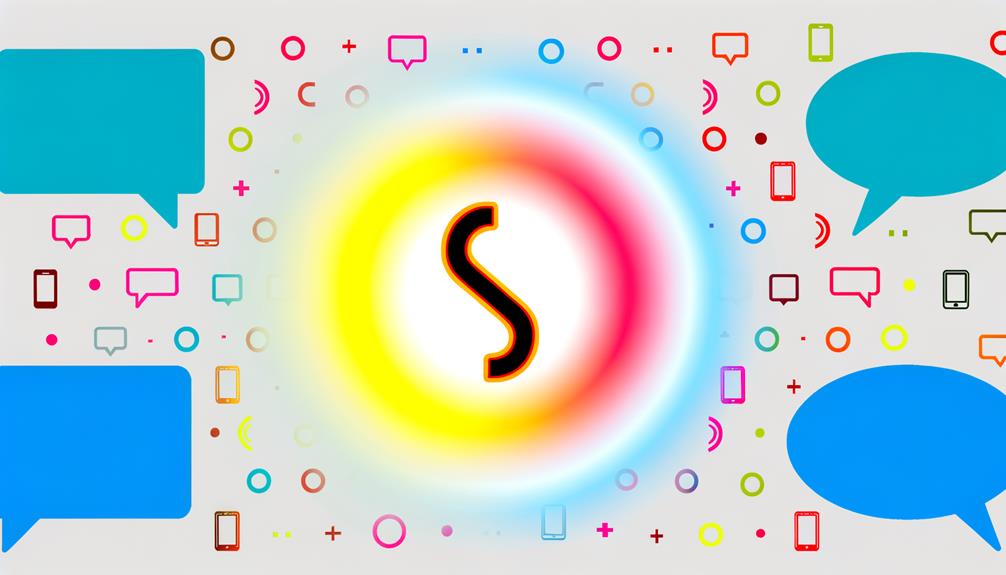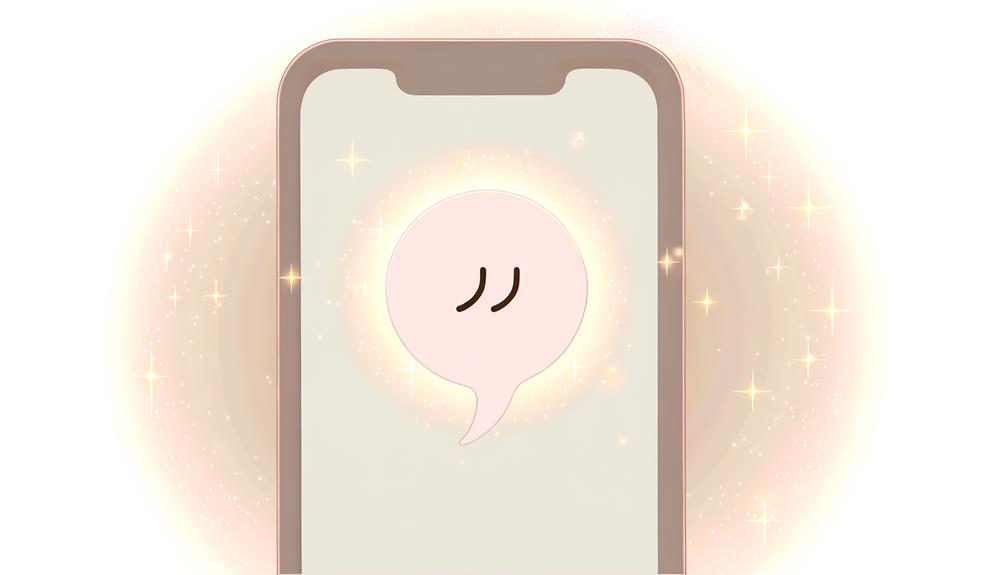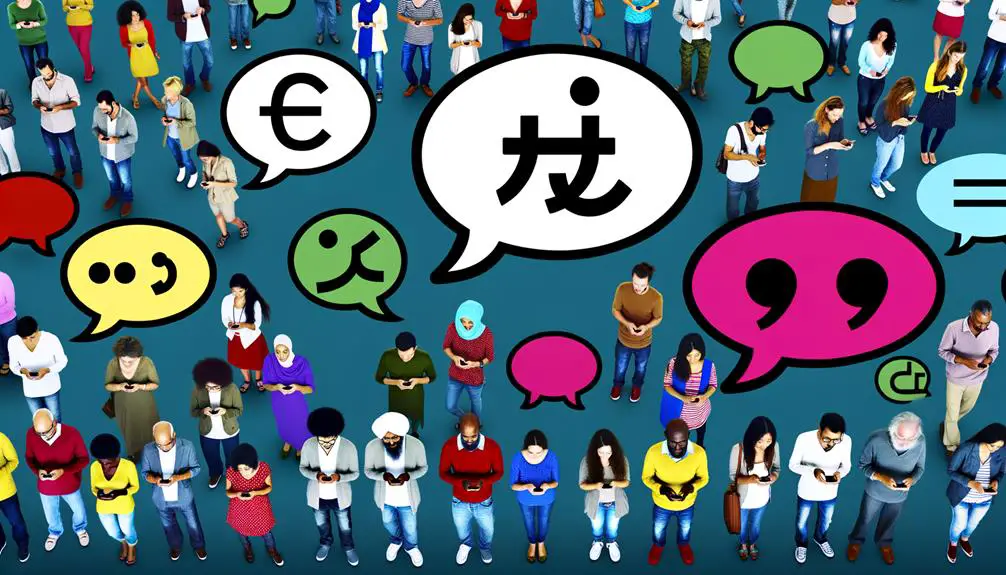What Is the Meaning of the Tilde Symbol in Texting?
In texting, the tilde symbol (~) has evolved to serve various communicative purposes. Primarily, it indicates approximation, suggesting that a specific value or statement is not exact.
It also softens the tone of messages, making them appear more casual or light-hearted. Additionally, the tilde can convey a playful or sarcastic undertone, subtly altering the intent behind a message.
Its use varies globally, with interpretations ranging from friendliness and politeness in East Asia to informal nuances in Western contexts. Exploring these facets can provide deeper insights into digital communications and cultural nuances.

Key Takeaways
- The tilde symbol (~) often indicates a playful or light-hearted tone in text conversations.
- It is used to signify approximation or an estimate in informal contexts.
- In texting, it can soften statements or add a whimsical, informal nuance.
- The tilde can subtly convey sarcasm or a sardonic tone in messages.
- Its interpretation varies culturally, indicating friendliness in East Asia and informality in Western contexts.
Historical Background

Historically, the tilde symbol (~) has its origins in ancient manuscripts, where it was used as a shorthand notation for omitted letters or as a diacritical mark. This practice was prevalent in Latin and medieval Spanish texts, where the tilde indicated the omission of an 'n' or 'm' in certain words.
Its role evolved over centuries, becoming integral in various linguistic contexts. For instance, in Portuguese, the tilde serves as a diacritical mark to denote nasalization of vowels. Technological advancements have further diversified its applications, embedding the tilde in programming languages and mathematical notation.
Understanding the historical evolution of the tilde provides valuable insight into its multifaceted roles across different domains, underlining its adaptability and enduring relevance.
Common Uses
In modern texting, the tilde symbol (~) serves multiple functions, enhancing the expressive range of digital communication.
It is commonly employed as an informal tone indicator, signaling a casual or playful intent.
Additionally, it is used to denote approximate values or to convey a sense of playful ambiguity.
Informal Tone Indicator
The tilde symbol (~) is frequently employed in texting to convey an informal or playful tone, often softening statements or indicating approximation. This usage allows for nuanced expression and can alter the perceived severity or intent of the message. By incorporating the tilde, the sender can infuse a sense of casualness or lightheartedness, enhancing the communicative efficacy in digital interactions.
Adding a tilde can make a statement appear more joking or less serious, e.g., 'I'm so tired~'.
It can soften potentially harsh statements, e.g., 'That wasn't the best idea~'.
The symbol is often used in a flirtatious manner, subtly altering the tone, e.g., 'Miss you~'.
This nuanced use of the tilde assists in maintaining a congenial and approachable tone in text-based communication.
Approximate Value Signifier
Beyond conveying an informal tone, the tilde symbol (~) is also commonly utilized to indicate an approximate value in text-based communication. This usage is prevalent in scenarios where precision is unnecessary or unattainable but a general estimate is required.
For instance, '~5 minutes' signifies that the event will occur in about five minutes, allowing for minor deviations. The tilde serves as a practical tool for expressing estimations without committing to exact figures. This is particularly beneficial in informal or semi-formal contexts such as texting, where brevity and flexibility are valued.
Additionally, employing the tilde can enhance clarity by immediately signaling to the recipient that the provided value is not exact but a close approximation.
Playful Expression Marker
Utilized frequently in informal digital communication, the tilde symbol (~) often serves as a playful expression marker, adding a layer of casual nuance to the text. This usage can subtly alter the tone, suggesting a sense of humor or informality. The tilde's flexible application helps convey emotions and attitudes that might otherwise be lost in plain text.
Common uses include:
- Sarcasm: Softens the impact of sarcastic remarks or jokes.
- Approximation: Indicates an estimate or an informal guess in a non-serious context.
- Whimsy: Adds a whimsical, light-hearted tone to statements, particularly in friendly conversations.
Understanding these nuances can enhance digital communication, making messages more engaging and contextually appropriate.
Indicating Sarcasm

In digital communication, the tilde symbol (~) is often employed to convey a tone of sarcasm. This usage serves as a subtle, yet effective, means of indicating that the literal interpretation of the text should be re-evaluated.
For instance, a statement like 'Oh, you're so ~punctual~' suggests the opposite of punctuality. The tilde acts as a non-verbal cue, guiding the reader to perceive an underlying sardonic intent.
Unlike explicit markers such as '/s' for sarcasm, the tilde offers a nuanced, context-dependent signal. Its effectiveness hinges on shared understanding among communicators, necessitating familiarity with its sarcastic connotations.
This method enriches textual interactions by embedding layers of meaning without overt explanation, enhancing interpretative depth in digital discourse.
Playful Tone
While the tilde symbol (~) is adept at conveying sarcasm, it also frequently serves to inject a playful tone into digital conversations. This versatile symbol can soften statements, making them seem more light-hearted and less severe. It is often employed to add a whimsical or flirtatious nuance to messages, helping to convey a sense of informality and fun.
The tilde can be used in various contexts to signal a playful tone:
- Friendly teasing: “You're always late~”
- Flirtation: “Missed you~”
- Casual suggestions: “Let's meet at 5-ish~”
Gentle Reminder

The tilde symbol (~) can also serve as a subtle tool for delivering gentle reminders in digital communication. When utilized in this particular situation, the tilde often signifies a non-urgent, friendly nudge to remind someone of a task or event.
Its inclusion in a message can soften the tone, making the reminder appear less demanding and more approachable. This application leverages the inherent informality of the tilde to mitigate any perceived pressure.
For instance, 'Don't forget the meeting tomorrow~' conveys a reminder with a touch of casualness. The tilde serves as a practical device in professional and personal text exchanges, fostering a collaborative atmosphere by reducing the abruptness often associated with reminders.
Textual Emphasis
Leveraging the tilde symbol (~) in texting can effectively emphasize specific words or phrases, drawing attention to key points in a message. This usage of the tilde can add nuance and subtle emphasis without resorting to more aggressive forms of highlighting, such as capitalization or exclamation marks. This technique is particularly useful in digital communication to convey tone or importance.
Common applications include:
- Highlighting: Surrounding a word with tildes to underscore its significance, e.g., ~important~.
- Nuance Indication: Using tildes to suggest a playful or sarcastic tone, e.g., ~sure~.
- Softened Emphasis: Adding emphasis without the intensity of bold or italic formatting, e.g., ~interesting~.
This method aids in maintaining clarity and enhancing the readability of text-based communication.
Cultural Differences

The tilde symbol's meaning in texting can vary greatly across different cultures, influenced by regional usage variations and global interpretations.
For instance, in some Western contexts, the tilde may indicate sarcasm or a playful tone, whereas in East Asian texting, it can convey politeness or soften statements.
Understanding these cultural nuances is vital for accurate communication and preventing potential misunderstandings in international digital interactions.
Regional Usage Variations
Different cultures and regions exhibit unique conventions and meanings when utilizing the tilde symbol in digital communication. These variations can lead to diverse interpretations and usage patterns, which are essential to understand for effective cross-cultural communication.
- In Japan, the tilde (~) is frequently used to indicate a drawn-out sound or to convey a sense of casualness and relaxation in conversation.
- In Spanish-speaking countries, the tilde is sometimes employed to soften the tone of a statement or to express approximation, such as 'about' or 'around.'
- In the United States, the tilde is often used in informal contexts to signify approximation or to add a playful tone to the text.
Understanding these regional nuances can enhance clarity and prevent miscommunication in digital interactions.
Symbol Interpretations Globally
Examining the global interpretations of the tilde symbol reveals that its usage and significance can vary widely across different cultural contexts. In Western countries, the tilde often conveys a sense of approximation or uncertainty in informal communication. Conversely, in East Asian cultures, it is frequently used to express a tone of friendliness or politeness in digital messages.
| Region | Interpretation |
|---|---|
| Western | Approximation, Uncertainty |
| East Asia | Friendliness, Politeness |
| Latin America | Typographic Accent, Informality |
Latin American users employ the tilde primarily in its grammatical role, affecting pronunciation and meaning in their languages. Understanding these cultural nuances is vital for effective global communication, as misinterpretation can lead to unintended messages. Consequently, adapting to regional practices is essential for digital interactions.
Future Trends
As digital communication continues to evolve, the utilization and interpretation of the tilde symbol in texting are likely to undergo significant transformations. Emerging trends suggest that this symbol will adapt to new contexts and technologies.
With the rise of artificial intelligence and natural language processing, the nuances of tilde use may become more intricate and personalized. Users are expected to leverage the tilde for:
- Enhanced expression: Conveying sarcasm, irony, or ambiguity with increasing sophistication.
- Cultural adaptation: Shifting meanings based on regional and cultural influences.
- Integration into new platforms: Adoption in diverse digital interfaces beyond traditional texting, such as augmented reality and voice-to-text applications.
Understanding these trends will be essential for deciphering future digital communications.
Conclusion
The tilde symbol (~) in texting has evolved to convey various meanings, including sarcasm, a playful tone, gentle reminders, and textual emphasis. Its usage demonstrates the adaptability of textual communication to convey nuanced emotions and intentions.
For instance, in a hypothetical scenario, a message stating 'Sure, you're always on time~' employs the tilde to imply sarcasm. Understanding these subtleties is essential for effective digital communication, as cultural differences and future trends continue to shape its usage.






